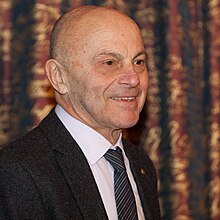Eugene Fama
American economist and Nobel laureate in Economics
Eugene Francis "Gene" Fama (born February 14, 1939) is an American economist and Nobel laureate in Economics with Lars Peter Hansen and Robert J. Shiller, known for his work on portfolio theory and asset pricing, both theoretical and empirical.

Quotes
edit- The question is when is active management good? The answer is never.
- Cited in: Lawrence Delevingne. "Nobel winner Fama: Active management 'never' good." at cnbc.com. 19 Sept. 2014.
- If active managers win, it has to be at the expense of other active managers. And when you add them all up, the returns of active managers have to be literally zero, before costs. Then after costs, it's a big negative sign
- Cited in: Lawrence Delevingne. "Nobel winner Fama: Active management 'never' good." at cnbc.com. 19 Sept. 2014.
Common risk factors in the returns on stocks and bonds, 1993
editFama, Eugene F., and Kenneth R. French. "Common risk factors in the returns on stocks and bonds." Journal of financial economics 33.1 (1993): 3-56.
- If assets are priced rationally, variables that are related to average returns, such as size and book-to-market equity, must proxy for sensitivity to common (shared and thus undiversifiable) risk factors in returns. The time-series regressions give direct evidence on this issue. In particular, the slopes and R2 values show whether mimicking portfolios for risk factors related to size and [book-to-market] capture shared variation in stock and bond returns not explained by other factors.
- p. 4-5
- Although size and book to market equity seem like ad hoc variables for explaining average stock returns, we have reason to expect that they proxy for common risk factors in returns.
- p. 7
- Firms that have a high BE/ME (a low stock price relative to book value) tend to have low earnings on assets. Conversely, low BE/ME (a high stock price relative to book value) is associated with persistently high earnings.
- p. 8
- The empirical successes of [the three-factor model] suggest that it is an equilibrium pricing model, a three-factor version of Merton’s (1973) intertemporal CAPM (ICAPM) or Ross’s (1976) arbitrage pricing theory (APT). In this view, SMB and HML mimic combinations of two underlying risk factors or state variables of special hedging concern to investors.
- p. 57
Quotes about Eugene Fama
edit- Our results are disturbing in that, like Fama and French (1992), they suggest that traditional measures of risk do not determine expected returns. In equilibrium asset pricing models the covariance structure of returns determines expected returns. Yet we find that variables that reliably predict the future covariance structure do not predict future returns. Our results indicate that high book-to-market stocks and stocks with low capitalizations have high average returns whether or not they have the return patterns (i.e., covariances) of other small and high book-to-market stocks. Similarly, after controlling for size and book-to-market ratios, a common share that ‘act like’ a bond (i.e., has a low market beta) has the same expected return as other common shares with high market betas.
- Kent Daniel and Sheridan Titman (1997, p. 4) as cited in: Lin, Xiaoji, and Lu Zhang. "Covariances, characteristics, and general equilibrium: A critique." (2011).
- There is no way to predict the price of stocks and bonds over the next few days or weeks. But it is quite possible to foresee the broad course of these prices over longer periods, such as the next three to five years. These findings, which might seem both surprising and contradictory, were made and analyzed by this year’s Laureates, Eugene Fama, Lars Peter Hansen and Robert Shiller.
- "The Prize in Economic Sciences 2013," at nobelprize.org.